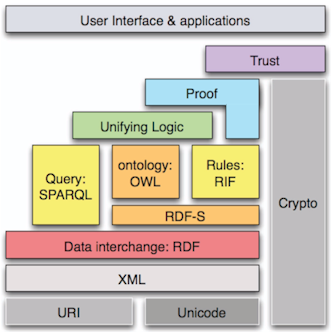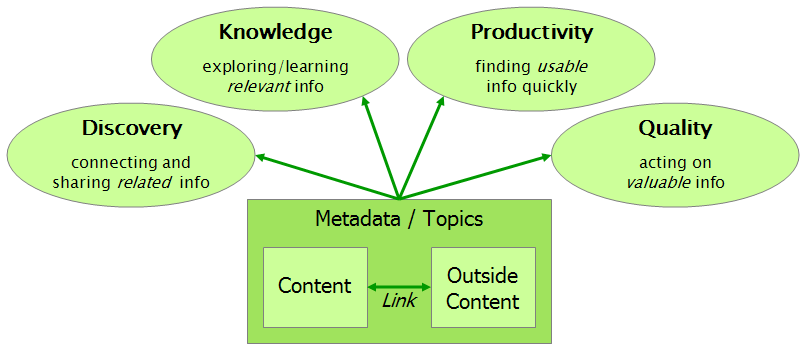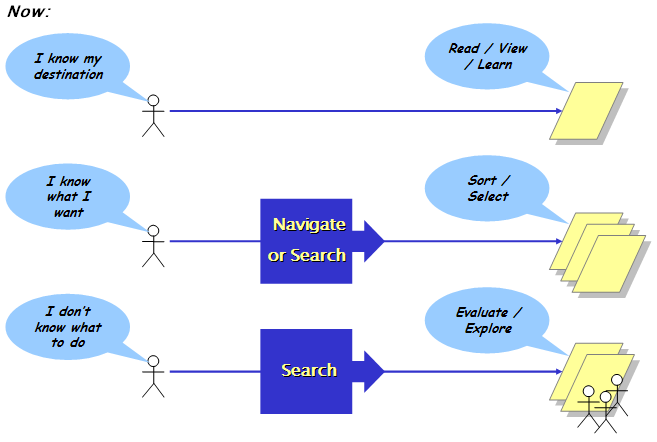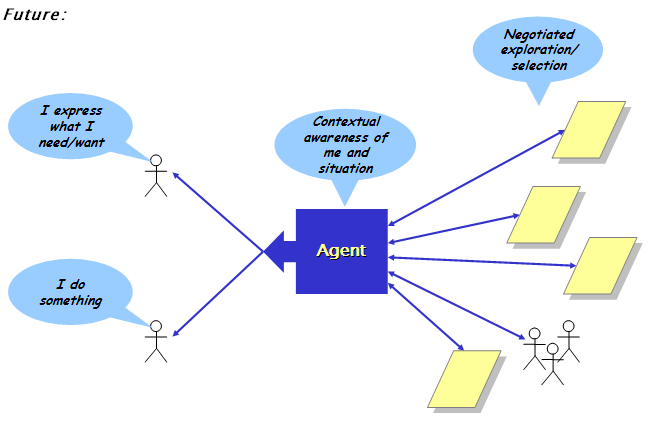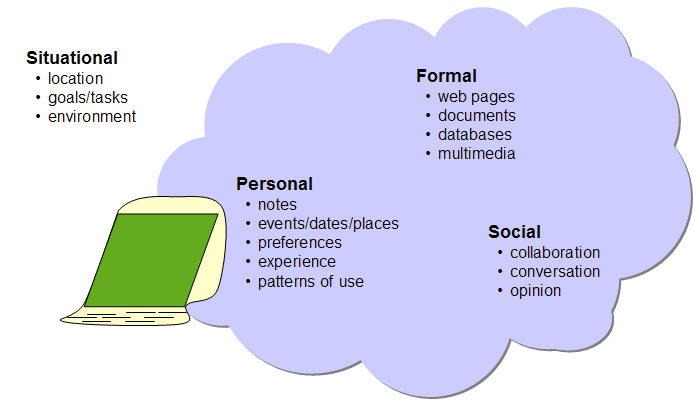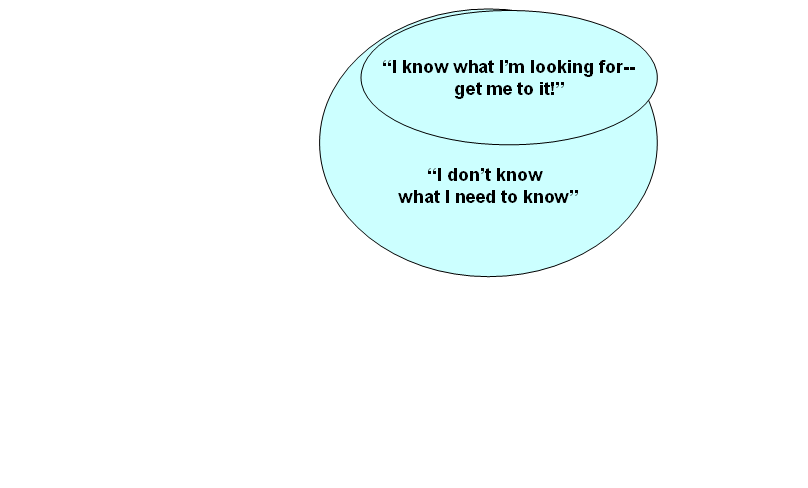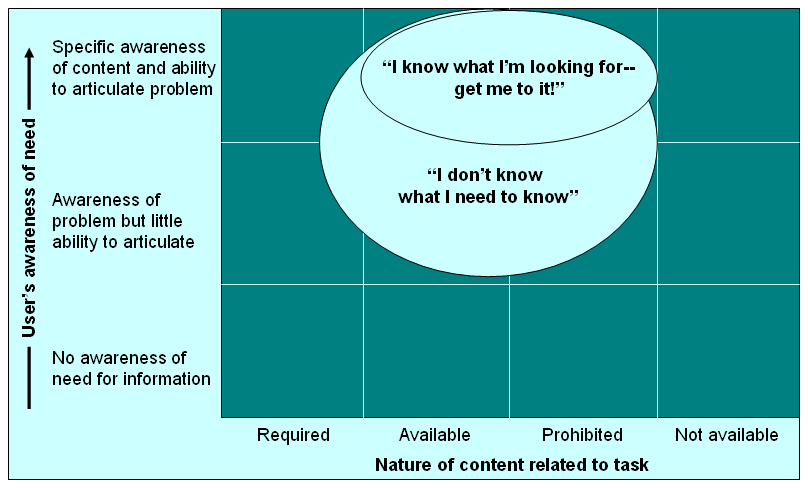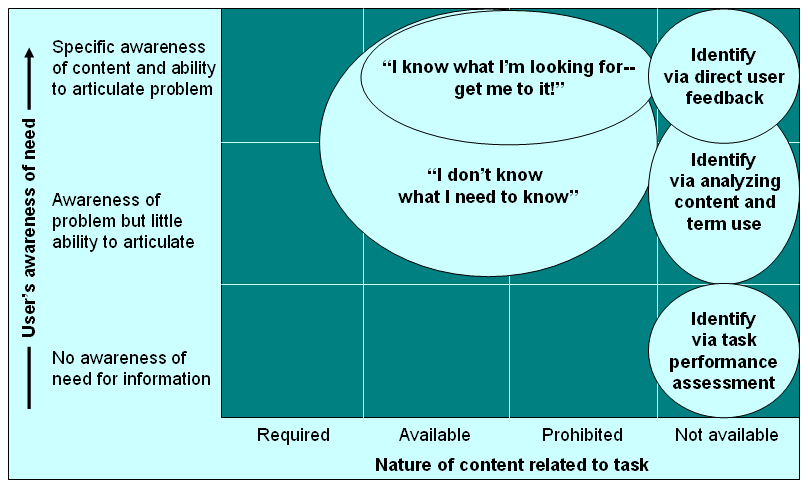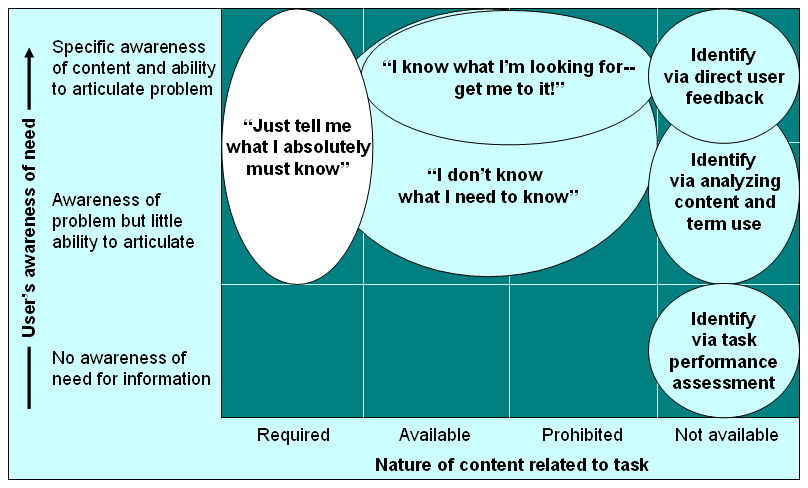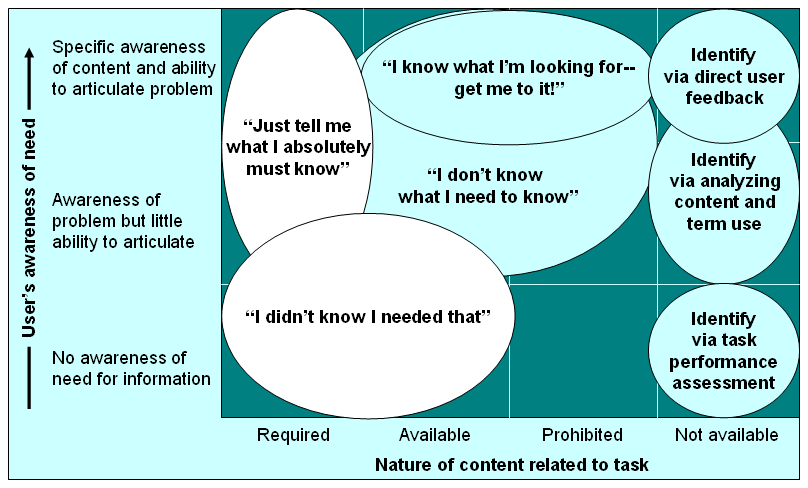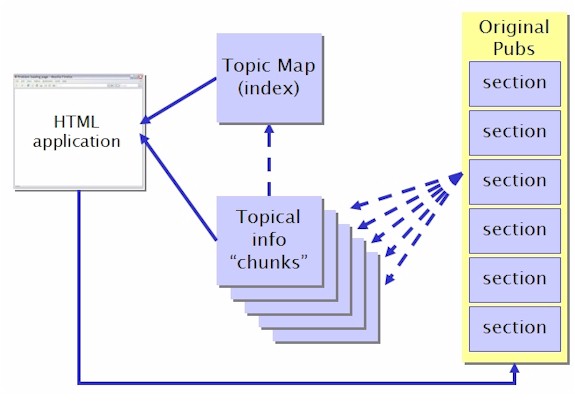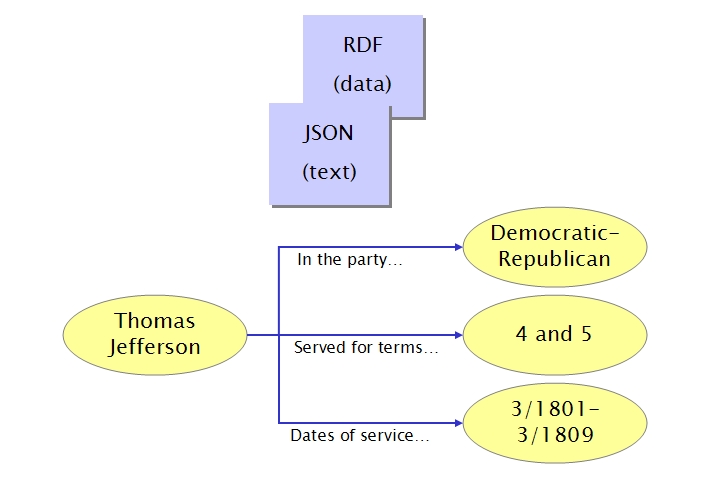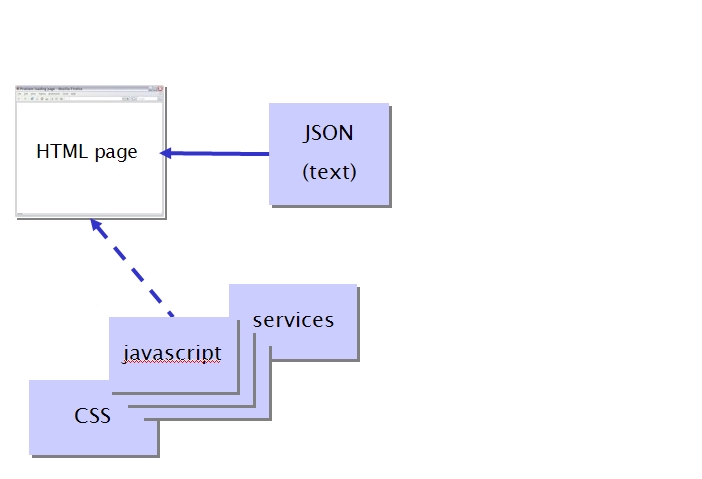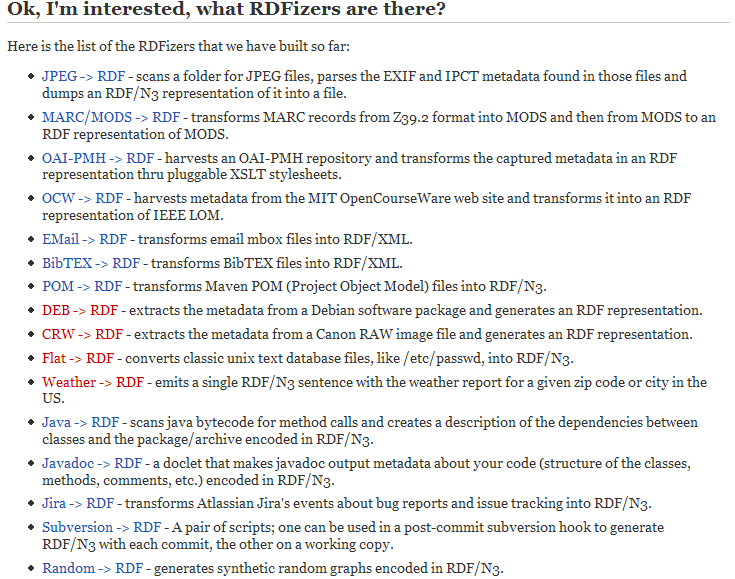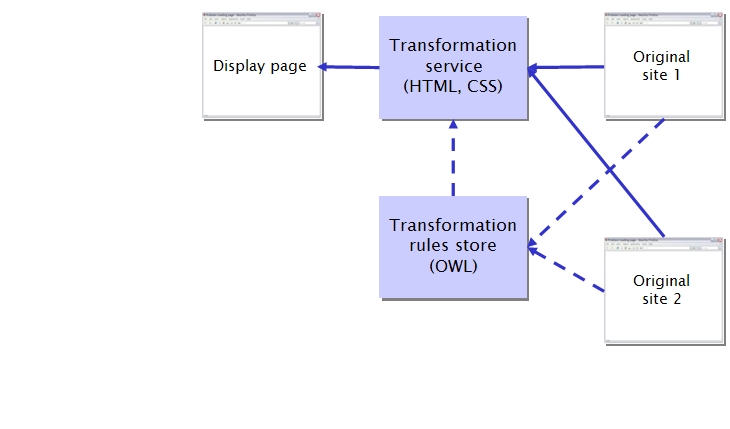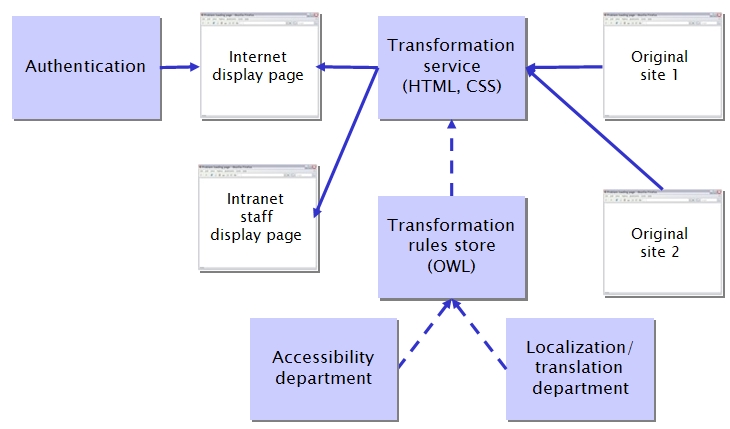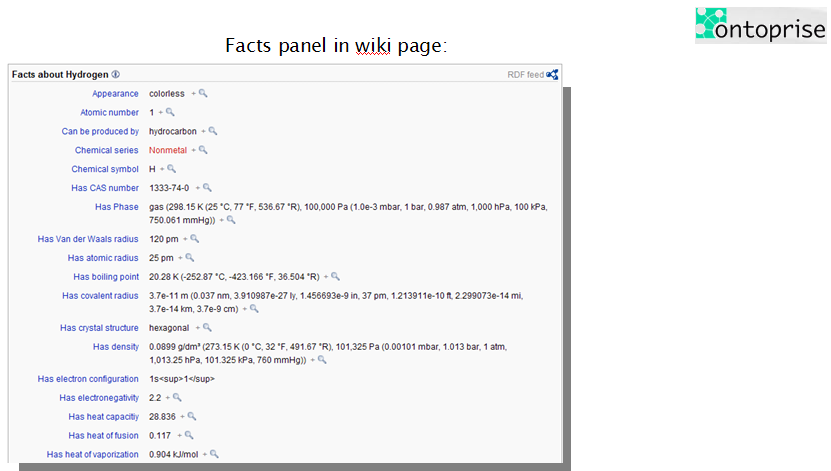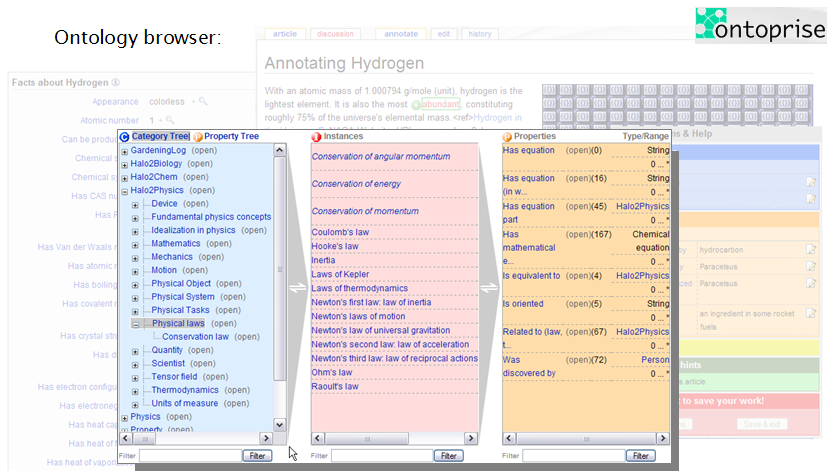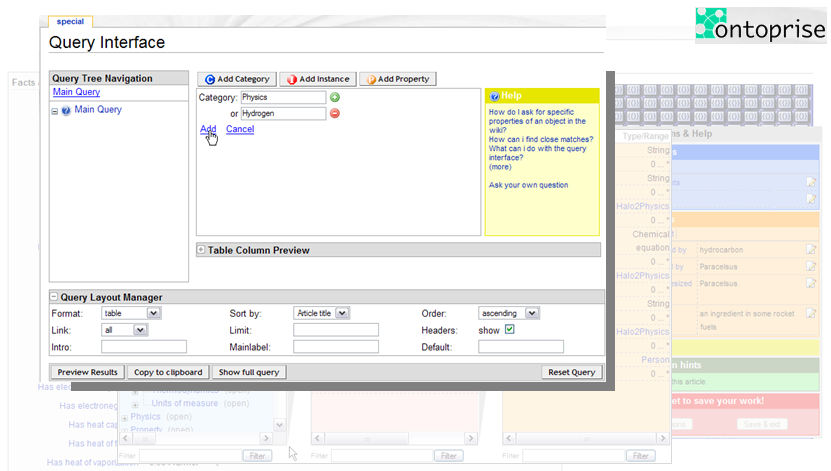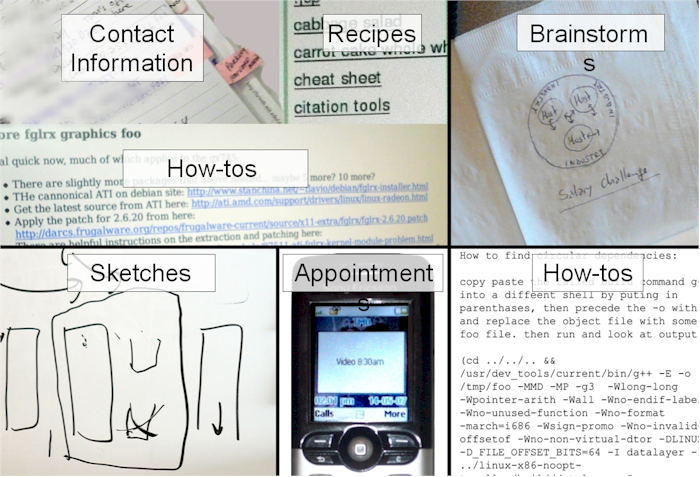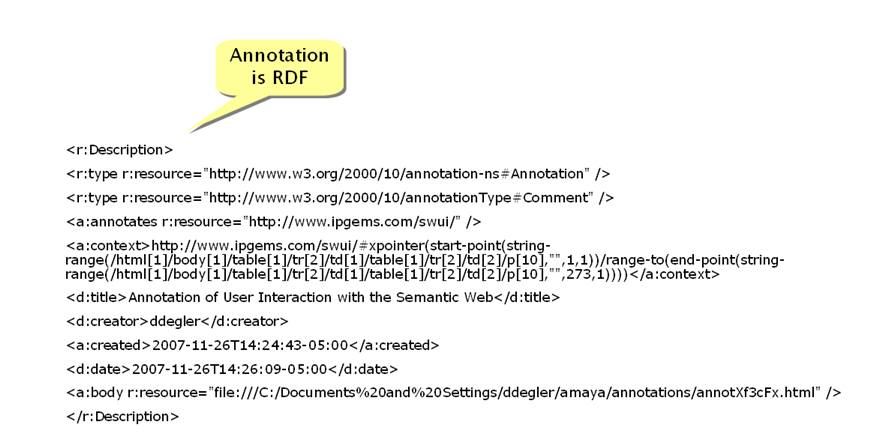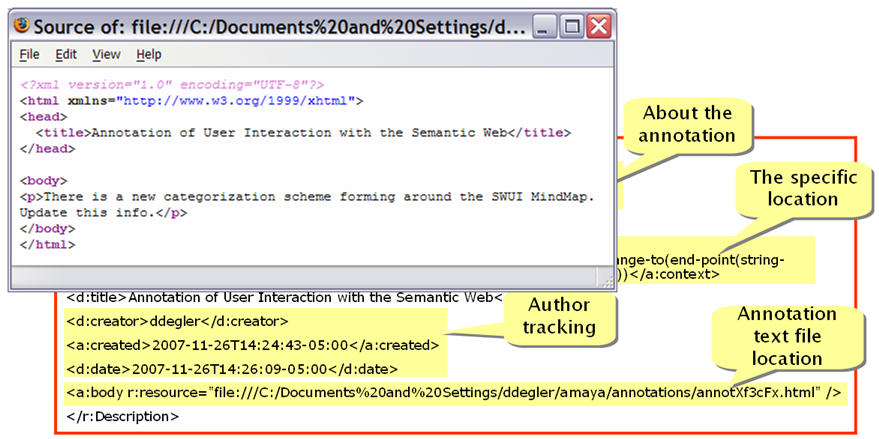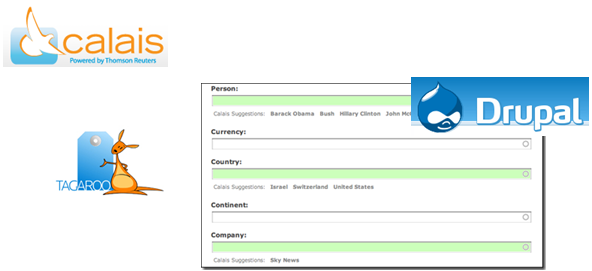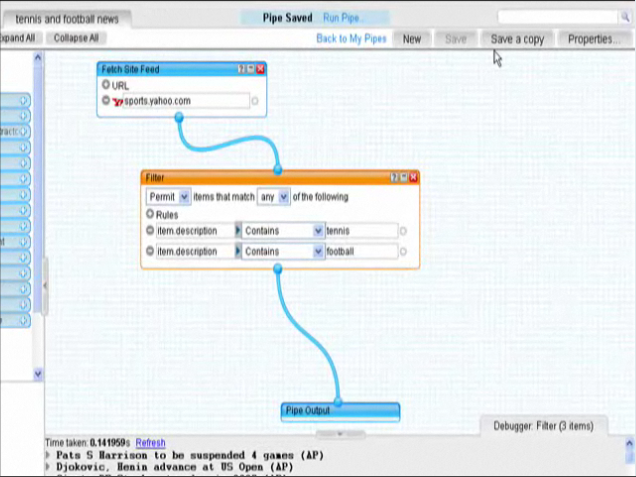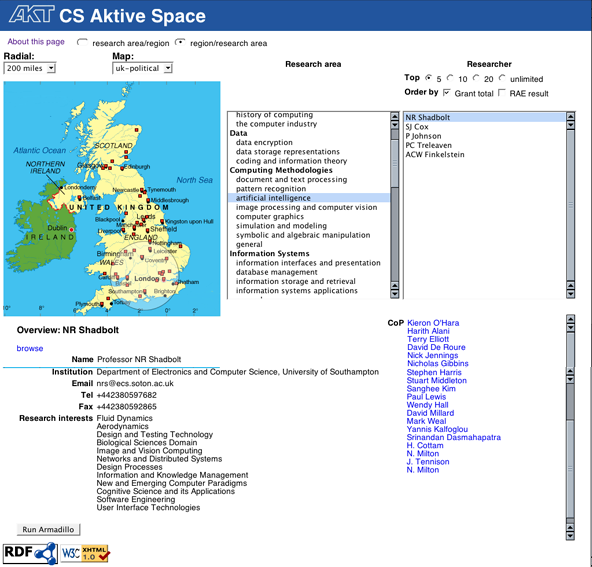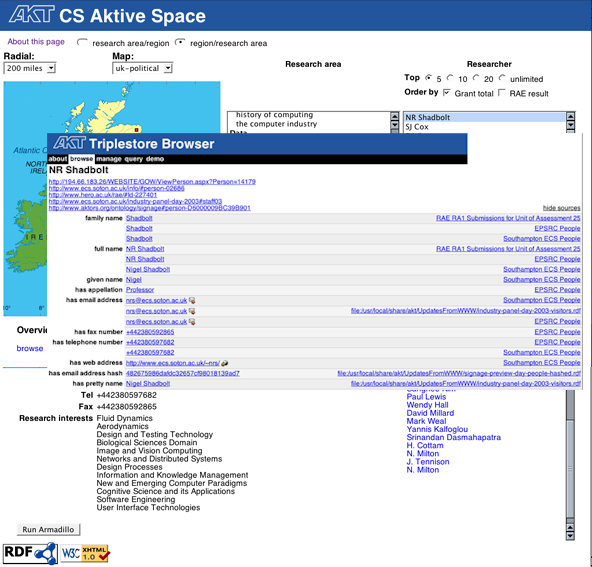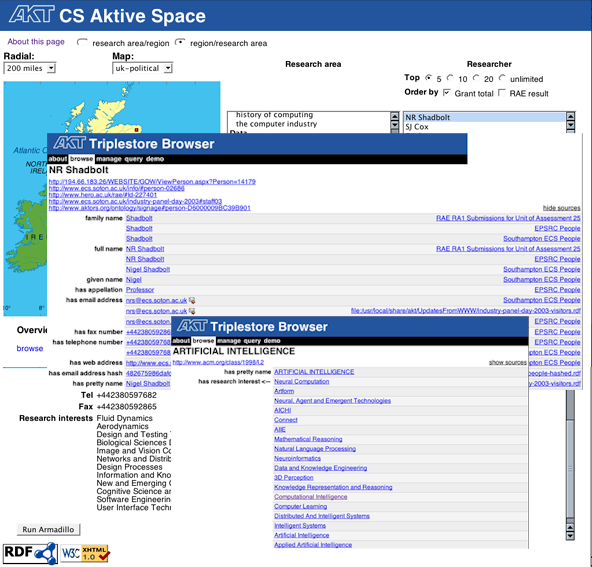-->
So today we explore...
- A brief overview: What is it?
- Considering value: What problems are we trying to solve?
- Examples and demos:
- Navigating information landscapes
- Searching information landscapes
- Creating and sharing information
- Personal and social issues: provenance, transparency, shared data and privacy
Why now?
"As interface stands on the shoulders of infrastructure,
tomorrow's user experience will rest on the foundation of today's
Semantic Web technologies."
Peter Morville, Ambient Findability, 2005, p. 170
Why now?
... analogy thanks to Nathalie Barthe
- The infrastructure of energy was initially stand-alone... we foraged, made, or bought locally
- Local power generation, particularly co-located with industry sites
- Power lines and the 'grid'... standards, and a visible sign of the infrastructure's existence
- Buried lines... out of sight, but relied upon
- Eventually...
- Nearly invisible, relatively standardized resource
- Additional uses... like audio speakers riding the home wiring
- Different innovations/sources
- ... and local initiatives that give back to the grid
Evolving understandings
- The "Semantic Web"... a grand vision
- The "semantic web"... heterogeneous, interconnected, self-describing, lightly structured
- Web 2.5... or Web 3.0...?
- ... or "Linked Open Data" on the web?
- Eventually, just... the Web...?
The formal view of the Semantic Web (9.2006)
Berners-Lee et al, September 2006. Fig. 3.2 The Semantic Web Stack c.2006. Page 22.
In "A Framework for Web Science." Foundations and Trends in Web Science. Vol. 1, No 1 (2006).
http://www.nowpublishers.com/product.aspx?product=WEB&doi=1800000001
- User Interaction introduced as part of the overall framework
- Lots of conversations in the community about how important this is
- Progress not only in the standard-setting process, but also in the evolution of tools and uses
Whoa! Jargon check!
Metadata
- Inward-looking: data about the content or application itself
- Outward looking: the situations, tasks, context, and real world subjects
- Cross-referring: the relationships that an item of content participates in
- Embedded: the internal structure of content and its markup
Metadata is an enabler
The imperative for Usability and Interaction Design involvement
"Well, you said that for people to be able to handle data they need a lot of skill...
We do not yet have Semantic Web technology available which is that easily usable by grandparents and children. That is true."
Tim Berners-Lee, "The future of the Web as seen by its creator"
in an interview with Peter Moon, IDG Now, July 9, 2007
http://www.itworld.com/Tech/4535/070709future/pfindex.html
"After 10+ years of work into various aspects of the Semantic Web...
I am now fully convinced (read: no longer in denial) that most of the remaining challenges to realize the Semantic Web vision have nothing to do with the underlying technologies...
Instead, it all comes down to user interfaces and usability."
Ora Lassila, "Semantic Web Soul Searching"
Wilbur-and-O blog, March 19, 2007
http://www.lassila.org/blog/archive/2007/03/semantic_web_so_1.html
What problems are we trying to solve?
- Relevance
- Directness
- About-ness
- Reliability and provenance
- Scalability
- Usability:
- context
- relationships
- integration
- meaning
Some things to think about
- It's about the lines, not the items!
- User-centered, rather than publisher-centered
Some things to think about
- It's about the lines, not the items!
- User-centered, rather than publisher-centered
- Vision of rich context: formal, social, personal, situational
- A seamless user experience... user goals and tasks are facilitated easily, no matter what technologies and applications involved
- Based on frictionless data... data is free to move between applications and uses as needed
Some things to think about
- It's about the lines, not the items!
- User-centered, rather than publisher-centered
- Vision of rich context: formal, social, personal, situational
- Relevant and pro-active information
Some things to think about
- It's about the lines, not the items!
- User-centered, rather than publisher-centered
- Vision of rich context: formal, social, personal, situational
- Relevant and pro-active information
- Current themes:
- data entry
- using large public data sets
- common part of the architecture on many more sites
Themes
- Five broad themes:
- Navigating information landscapes
- Search and natural language interaction
- Creating and sharing information
- Vocabulary and relationship management
- Personal and social issues: provenance, transparency, shared data and privacy
- Themes derived from Lisa Battle's 2006 analysis of Semantic Web research and projects: Preliminary Inventory of Users and Tasks for the Semantic Web
Navigating Information Landscapes
What is useful? What challenges exist?
Navigating information landscapes
IRS TaxMap
Created by InfoLoom
- Starts with highly structured information
- Call centers - high volume, public language
- Adds:
- Index-like topic access
- Alternative terms more in line with the public
- Contextual relationships to other topics
Navigating information landscapes
Exploring facets
- Categories that you control and select
- It's becoming common for eCommerce and large site navigation
- Increased relevance for users
- There are two types of interaction: filtering and browsing
- Filtering is about starting with large lists and narrowing... a relevance funnel
- Browsing is about exploring the structure of the data to find useful areas of interest
Navigating information landscapes
Exhibit: Simple faceted filtering
Created by the SIMILE group, MIT
- It's how the Web grew: "see what I did, copy it, try it"
- Lightweight data structure... emphasis on structure
Navigating information landscapes
Exhibit: Simple faceted filtering
Created by the SIMILE group, MIT
- Re-usabe/sharable controls could lead to a more consistent experience
Navigating information landscapes
RDFizers: converting between formats to easily create structured data
Created by the SIMILE group, MIT
Navigating information landscapes
mSpace and mSpace Mobile: facet browsing
Created by IAM Group, ECS, Southampton, UK
- Semantic Challenge winner, 2004
- "Throw it over" any structured data - even mashups
- Start with any facet, move in any direction
- Considerations?
- How easy to add new facets?
- Will people easily grasp that they control sequence of facets?
- Locational context - a primary "filter"
- Start with "what do I want to know here?"
- Add social recommendation - based on my friends
- Focus+Context for small screens
Navigating information landscapes
Multimedia eCulture: Rijksmuseum, Netherlands facet data for browsing
Created by CWI, Netherlands
- Semantic Challenge winner, 2006
- Rich metadata, with ability to link to other international data sets
- Faceted search results, browsing rather than filtering
- Challenges:
- Labeling
- What metadata to show, what to hide?
- Is the interaction sufficiently... or too... "serendipitous"?
Navigating information landscapes
Tag-based navigation
Thanks to Kate for letting me illustrate the del.icio.us challenge...
- Tags are now a common sight, and they solve real needs
- ...but, tags are having some trouble morphing into "folksonomies" and they don't scale well
- They have another challenge - two different motivations:
- Unique identity, for personal findability
- Generic descriptor, for social visability
- Trend: grouping tags
- Trend: Suggestions based on structured data sets, better semantic integration, e.g.:
- Defined terminology database
- Wikipedia subjects
- Semantic relationships for tags, links, and people
Navigating information landscapes
Adding visualization: AquaBrowser
Created by Medialab Solutions, Netherlands
- Mutliple modes of interaction
- Adding a visual star browser
- What is the efficacy of multi-format interactions? Needs exploration...
Navigating information landscapes
SADIe: a unique use of SW technologies for accessibility
Created by Universities of Manchester and Aberdeen, UK
Search and the possible role for natural language interaction
Is there something other than "keywords"?
Searching information landscapes
Keywords, meaning, and natural language
- Search is still dominated by keywords and flat lists
- More focus now on results page and refinement
- Increasing visualization, use of metadata, clusters/facets
- Many search algorithms are geared toward huge data sets (i.e. the entire Web) and little metadata availability
- Is natural language too "heavy" or too fragile?
- How useful is an intermediate step, such as "structured natural language" for more controlled environments?
Searching information landscapes
Complex search, where semantic data relationships play a role
- Synthesis and exploration... not just targeted or 'good enough'
- High context with implicit as well as explicit relationships
- For example:
- What Greek restaurants are open after 10pm within three blocks of a movie theatre where I can see the latest DiCaprio film?
...and can I get there in 45 minutes, with current traffic?
- How do I process this claim for a back treatment while the patient was on vacation in Maryland? Is it subject to the new legal requirements now in effect in her home state of Texas?
- A new crop of search tools arriving...
- Parsing search phrase/sentence structure to try and support context identification
- Using concept extraction and ontology integration in back-ends to improve context identification
- Like so much in search, could use more usability work
Since I gave this talk in June 2008, PowerSet has been acquired by Microsoft, so I think it's fair to say that next generation tools have arrived once you attach names like Microsoft and Yahoo to the trends...
Searching information landscapes
Structured natural language search
Created by Dynamic & Distributed information Systems Group, University of Zurich
- Recent user research on different levels of structure, language, interaction
How Useful Are Natural Language Interfaces to the Semantic Web for Casual End-Users?
by Esther Kaufmann and Abraham Bernstein, ISWC 2007
- "The results of the study reveal a clear preference for full sentences as query language and confirm that NLIs are useful for querying Semantic Web data."
- "...a highly significant preference for full-sentence queries independent of the retrieval performance."
- "One of the most prominent qualitative results was that several users, who rated Querix as best interface, explicitly stated that they appreciated the 'freedom of the query language.'"
- With full-sentence questions, users can communicate their information need in a familiar and natural way without having to think of appropriate keywords
- People can express more semantics when they use full sentences and not just keywords.
Creating and sharing information...
What a difference a year makes!
Data entry and annotation
Sites that share information
Creating and sharing information
If you don't have the data, what do you have?
- We all know: having users enter metadata is crazy
- ... or is it? Maybe it's just hard?
- Increasing focus on capturing, extracting, sharing, and organizing structured data
- Lightweight data entry interfaces
- Significant public datasets available
Creating and sharing information
LepTree, Splickr, and Spotter: biology community support
Created by Univ. Maryland Baltimore Campus (part of AToL project)
- LepTree community site: Drupal-based content management system with semantic triple-store
- AJAX techniques allow structured data entry "in place" - using an ontology for selection fields
- Splickr: annotating content with metadata, at the same time providing that metadata to the archive for other uses
- Spotter: map-based locating and accessing blog entries created with Splickr
Creating and sharing information
Semantic Wiki: semantic extensions to the popular MediaWiki
Created by Ontoprise and Instititue AIFB, Universitat Kalrsruhe, Germany
- You are reading a page about "Card Sorting" and see a link to "Information Architecture"
- In a regular wiki, IA would be typed in as [[Information Architecture]]
- In semantic wiki, IA would be typed in as [[method used for::Information Architecture]], which reads (to a semantic parser): "Card Sorting is a method that is used when doing Information Architecture [link]"
- An expected amount of session time might be stated in the article on "Card Sorting"
- In a regular wiki, you can read the anticipated time, but the computer can't
- In semantic wiki, type in [[expected duration:=1 hour]], i.e. "A card sort session has an expected duration of 1 hour"
- Builds on the success of MediaWiki (which drives Wikipedia)
- Syntax for relationships between topics as triples
- Not easy for the "average user" -- so they've been working hard on that...
Creating and sharing information
Semantic Wiki: semantic extensions to the popular MediaWiki
Created by Ontoprise and Instititue AIFB, Universitat Kalrsruhe, Germany
- New interfaces for three tasks:
- Adding relationship, category and property information to terms in the wiki page
- Browsing the ontology in the wiki
- Querying the ontology using structured query syntax to find particular information
Creating and sharing information
Personal Information Scraps
Simile Group, MIT and AIM Group, U. Southampton
- What are scraps?
- If "apps" are rich interaction with structured data, then...
- Scraps: lightweight capture of unstructured data with high contextual relevance
- Easy, lightweight, and flexible for different styles
- Jourknow, Inky, and AtomsMasher: exploratory and very interesting!
- Ethnographic process: study of scientists' PostIt notes, desks, notebooks, and computer filing:
Creating and sharing information
Personal Information Scraps
Simile Group, MIT and AIM Group, U. Southampton
- The group is working on a range of small interfaces to facilitate easy and useful scrap management. Here are a few examples (but keep your eye on this group, because they refine and improve the work regularly):
- Simple data capture
- Exploring context behind a particular scrap
- Relating scraps to other things
Creating and sharing information
Personal Information Scraps: Pidgin
Simile Group, MIT and AIM Group, U. Southampton
In order to facilitate people creating and managing scraps, they are looking at different levels of informal-to-formal syntax that might be used.
| |
sloppy pidgin |
|
jane 3pm diesel cafe |
|
"Sloppy parsed" to allow out-of-order matching and recursive nesting of typed templates. |
| |
tame pidgin |
|
Meet with Jane phone 617-555-1212 tomorrow at diesel cafe about SWUI submission |
|
Hand-written grammars for common domains, with semi-open SW-KB defined lexicon, and support for nested expressions. Not user-extensible or re-orderable. |
| |
clay pidgin |
|
meet 3pm with jane smith about swui |
|
User-defined N3 macro language using "means" templates written by the user. Support for nesting. No re-ordering clauses.
Template: "meet when with whom about what" means [ a :Meeting; vcal:start "when"; xcal:attendees "whom"; xcal:description "what"]. |
| |
n3+res pidgin |
|
swui mtg a Meeting; starts at: 3pm tomorrow; with jane; location Diesel Cafe |
|
N3 with entity and property and value resolution. Uses a colon or dash to delimit multi-word properties from their values, and semicolons to delimit clauses. |
Creating and sharing information
Annotation
- Annotating specific points within web pages - for research and review
- Key issues:
- When are they findable and useful?
- When found, how do annotations carry the context in which they were created... what were you thinking about at the time?
- How do we design with browser-embedded plug-ins in mind?
- Behind the scenes in Annotea, some of the structural concepts:
Creating and sharing information
PhotoStuff: archiving and annotating your photos
Created by MindLab, Univ. of Maryland
- Most photo sites now have annotations of portions of images... but it wasn't always this way
- PhotoShow (from 2002-2003) is annotation where data capture is tied to ontologies
- Load ontologies to get the initial classification options available
- For each classification item there is a set of "fields" for specific instance data
- Adding a new required data field can be done by adding an item in an ontology... no new code!
- Annotations are shareable
- They are also portable, if you decide to move from one photo site to another
Creating and sharing information
FOAF: Friend of a Friend
Collaborative project started by Libby Miller and Dan Brickley, 2000
- Common, sharable information about people... and their relationships to other people
- Increasingly used as the format for describing people
- Challenge: a person can have more than one... work-arounds are able to cross-refer, but they're not really easy
- Creating a FOAF profile could be much easier to do... and so could maintaining them
- Where can they be found?
- People's individual sites
- FOAF Bulletin Board (part of FOAF wiki)
- Semantically-rich commercial sites
- Social community sites like Tribe and LiveJournal
Vocabulary and Relationship Management
Vocabulary and relationships
Existing terminology sets
- There's a lot to learn from smart people and their published efforts
- Just because the vocabulary sets are available doesn't mean it's effort-free
- Many different formats, structures, purposes -- and licenses
Vocabulary and relationships
Concept extraction and term indentifiers
- TermExtractor: part of a European research project at an Italian University
- Not many of these out in the "free web" space
- Simple approach to uploading one or more files for rapid analysis
- Quite a lot of control over analysis... if you can understand what the controls offer!
- Gnosis: FireFox plug-in for on-the-fly concept identification
- Calais: a ThompsonReuters project to provide concept identification as a service
- Used by some (experimental) sites like LinkedFacts
- Used by Gnosis
- ... and more every day
Vocabulary and relationships
Extensions for content management systems
- Zemanta background searches based on the content you are creating in popular content management systems and blogs: plug-ins for WordPress, Moveable Type, Drupal
- Calais extensions for WordPress and Drupal for extracting concept metadata to be used as tags
Vocabulary and relationships
Yahoo Pipes
- Graphical mash-up builder
- Host the mash-up on their site, or use the API to embed it in yours
- pipes.yahoo.com
Vocabulary and relationships
Ontology editing and viewing
Protege editor, U.Stanford; Crop Circles by MindLab, U.Maryland / U.Manchester; TopQuadrant
What are some of the issues?
- Useful for bridging different sources with different data representations
- Complex data relationships
- Requires knowledge representation awareness and domain experience
- Collaborative editing is coming, but still early days
- Interactions and visualizations don't tend to scale well
- Maybe we need to find other ways? An open discussion...
Personal and Social Issues:
Provenance, transparency, shared data and privacy
Hot topics for longer-term consideration
Provenance, transparency, shared data and privacy
Tabulator: exploring existing data sets
Created by W3C (Tim Berners-Lee) and MIT CSAIL
- Recently released as a FireFox plug-in
- Useful to see sources of data, and connections between elements
- "Walks" the logic in the ontology
- Something that an ontology/data specialist or developer is most likely to use
Provenance, transparency, shared data and privacy
CS AktiveSpace: mashup of academic data, with provenance
Created by IAM, University of Southampton
- Can source information and provenance have >1 step back?
- Is this a generic browser function, rather than an application-by-application design?
Provenance, transparency, shared data and privacy
Inference Web: explanation interfaces
Created by Stanford University
- The logic in ontologies means "indirect" connections between question and answer
- What are queries and agents doing?
- Transparency: "how did you arrive at that answer?"
- Can anything more than the simplest, non-real-world logic be expressed in a way we can understand? What are user expectations?
Provenance, transparency, shared data and privacy
Informed consent: what's unique about the Semantic Web?
From presentation/paper by Paul Shabajee, SWUI2006

Provenance, transparency, shared data and privacy
Recommender systems and understanding "trust"
Jennifer Golbeck, MindLab, University of Maryland
- Do we perceive recommendations differently when we know who provided them?
- How can we better inter-connect our trusted relationships with other people?
- Since many of our relationships are context-specific (e.g. work, or family, or hobbies), how does a recommender system put things in the context of: 1) who we know, and 2) the situations where we interact with them?
- Jen's recent (2008) paper offers a range of study data on controlling factors and implications: Trust and Nuanced Profile Similarity in Online Social Networks (2008, ACM Transactions on the Web, to appear)
For your consideration...
How do we make sure the Semantic Web is:
- Better than the experience we have today
- So easy, anyone can describe themselves/their information semantically
- Able to clearly show what a "good" experience is (complete, understandable, transparent, semantically rich, trustable, not overwhelming), when much of the activity is happening in the background using semantic applications and agents
- Able to grow organically (and with few dependencies), while also moving toward the "web of meaning" idea
- Forgiving of differences in language and meaning, being clear and respectful of semantic "shades of gray"
- A trust-worthy and provable representation of us, our contexts, and our interests






